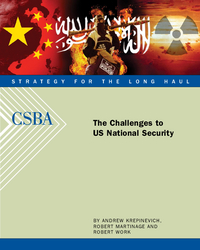
The United States is currently in a situation comparable to the one it confronted in the early days of the Cold War, when US civilian and military leaders were faced with a new and daunting challenge in the form of the Soviet Union. To address this challenge, a long-term national strategy to preserve American security was developed. In the aftermath of the Soviet Union’s collapse, the United States entered a period of relative calm — a “unipolar moment” in which its power was unrivaled and emerging threats to its security had not yet fully formed. Unfortunately, that period has been succeeded by a more dangerous era, as the United States now confronts several formidable challenges that may grow even more threatening in the years to come. The purpose of this report is to provide an overview of the three existing and emerging strategic challenges that are most likely to preoccupy senior decision-makers in the coming years:
- Defeating both the Sunni Salafi-Takfiri and Shia Khomeinist brands of violent Islamist radicalism;
- Hedging against the rise of a hostile or more openly confrontational China and the potential challenge posed by authoritarian capitalist states; and
- Preparing for a world in which there are more nuclear-armed regional powers.
Addressing these specific challenges should be at the forefront of the incoming administration’s strategic calculations, particularly during the 2009 Quadrennial Defense Review (QDR), which will help shape US defense strategy, planning, and force structure over the next 20 years.



























